Writing Your Thesis in Word 2013 and newer (Windows)
Below are instructions for performing the most common thesis formatting tasks in Word 2013 & 2016, for Windows. Make sure you are using the Word thesis template! Please see our general Word thesis instructions which is helpful no matter what version of Word you're using.
- Styles
- Inserting section breaks (Video Guide)
- Pagination
- Inserting images (Video Guide)
- Tables and Lists (Video Guide)
Styles
"Styles" are used in Word to easily apply a set of formatting attributes--such as font, font size, indentation, and spacing--consistently throughout a document. Learn more on our Word thesis page.
How to view and apply styles
- See the Styles toolbox in Word 2013/16: Click the Home tab and view styles off to the right. Click the bottom right pop-out button for the Styles toolbox to appear separately.

- You'll see the Styles Toolbox with the list of Styles.
- To see what style is applied to a particular part of text, select it in the document. The applied style will be shown in the Styles Toolbox.
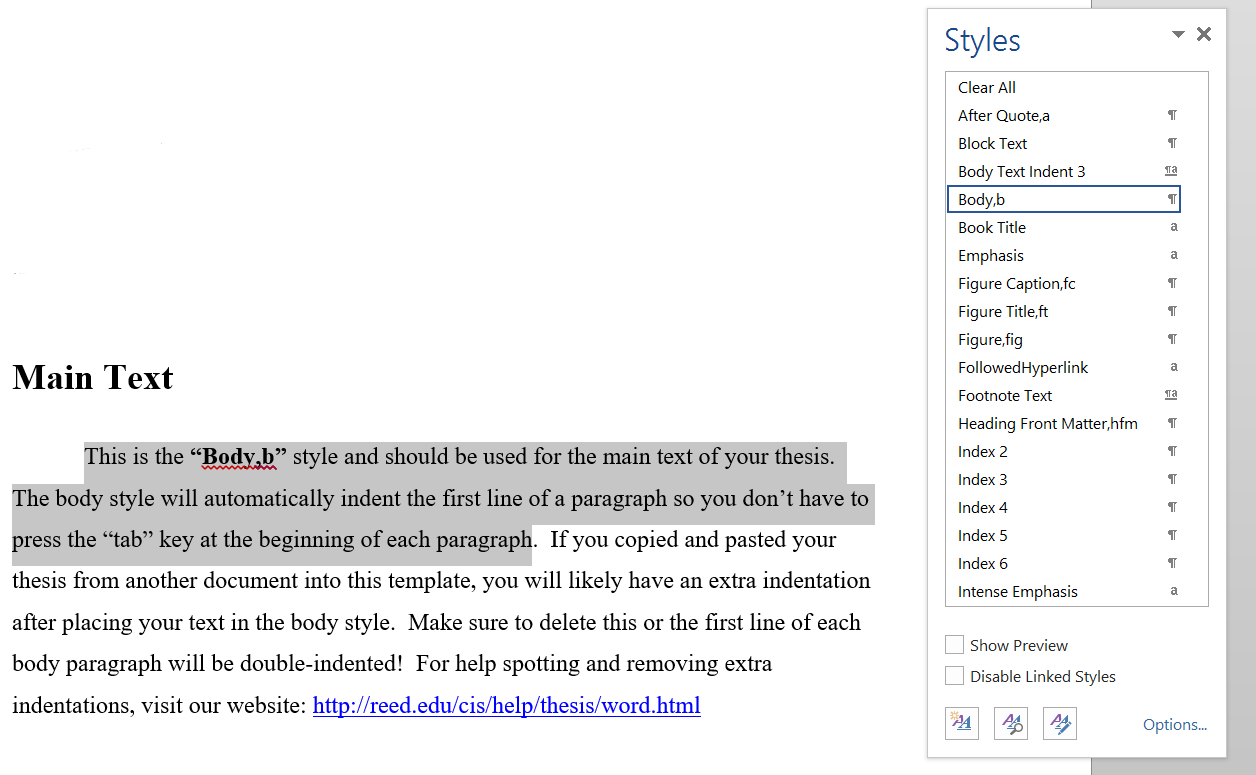
- To apply a particular style, select the text in the document (most styles are applied to an entire paragraph) and click the corresponding style in the Styles Toolbox.
- Occasionally the style won't be applied correctly. When this happens, choose "Clear Formatting", then apply the style again.
Modifying Styles
If you don't like a particular style, modify it to meet your needs!
- Right click on the style that you wish to change.
- Click the Modify button.
- Change the parameters you want. More options are available from the Format drop-down box.
- Click OK when you're done.
Section Breaks
The Word thesis template is formatted for double-sided printing. As a result, you need to insert an Odd section break at the end of each chapter and each section in the front matter. This ensures the first page of each chapter will start on an odd page (the right-hand side of a book).- Click the Show/Hide ¶ button to see what section breaks you already have.

- Go to Page Layout > Breaks.
- Choose Section Break (Odd Page)
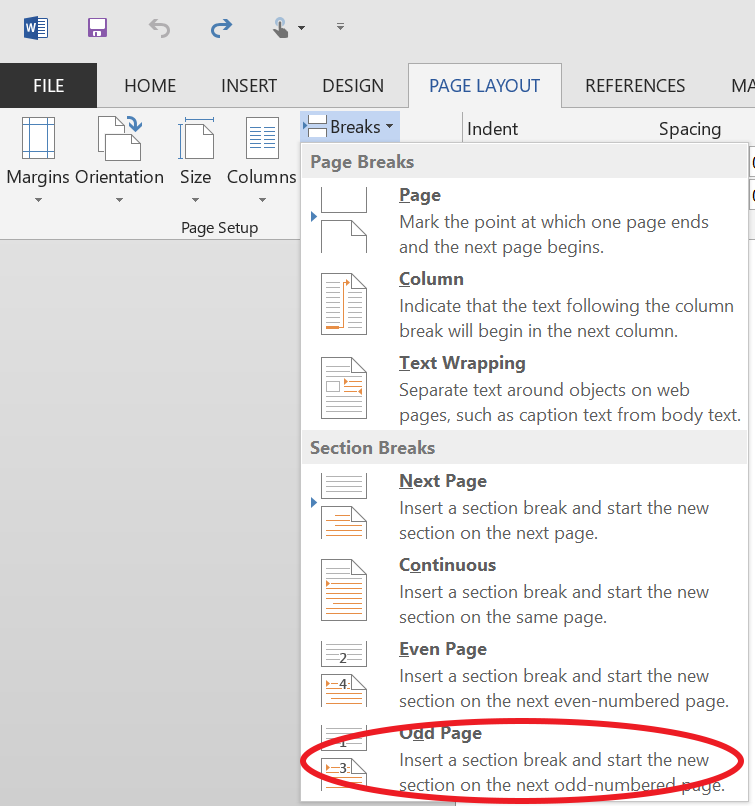
Note: If you've changed your thesis to be single-sided, you need to use "Next Page" breaks instead of Odd.
Tips:
- Only use one section break at a time. Multiple consecutive breaks create erroneous blank pages.
- If you need to force something to the following page (like an image), insert a regular page break (Insert menu > Break > Page Break)
Removing extra section breaks
Fixing broken section breaks
If you insert a section break and it messes up the previous section break, fix it this way:
- Page Layout > Line Numbers > Line Numbering Options
- Section start: Odd page
- Check "Different odd and even" and "Different first page"
- Apply to: "Whole document"
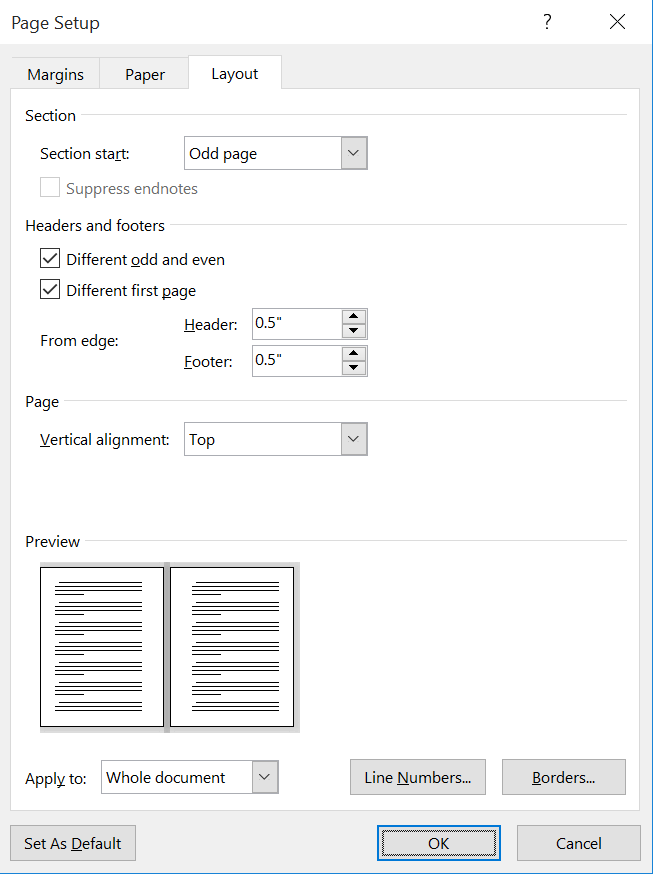
Pagination
The thesis template is set with correct pagination but it will probably break as you use it. Follow these guidelines for fixing it. Because it can be tricky, stop by the Help Desk if you get stuck.
How to make your Introduction start on page 1
The first page of your introduction should correspond to page "1"
- Double-click in the header area at the top of the page
- Click the Design tab, underneath the green "Header & Footer Tools" text. Make sure these are checked: "Different First Page", "Different Odd & Even Pages"
- Make sure "Link to Previous" is UNchecked.
- Go to the Insert menu > Page Number > Format Page Numbers
- Select "Start at" and "1".
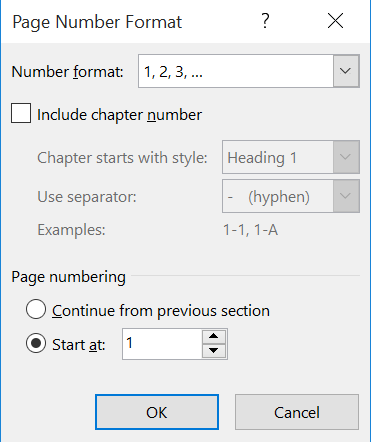
How to suppress page numbers on the first page of chapters
The first page of each chapter should not have a printed page number (but will count in the pagination).
- Make sure the correct section break is inserted at the end of the previous chapter (e.g., Odd section for double-sided format). See instructions above.
- Double-click in the header area at the top of the page.
- Click the Header and Footer tab. Make sure these are checked: "Different First Page", "Different Odd & Even Pages"

- If the page number still appears, select it and delete it. Then check the rest of the pagination to make sure it didn't break something else.
How to set continuous pagination (e.g., fix restarting at "1")
Page 1 starts on the first page of the first chapter (usually Introduction). Sometimes, numbering will restart in later parts in your document.
- Go to the page where numbering is incorrectly restarting at 1.
- Go to the Insert menu > Page Number > Format Page Numbers.
- Select "Continue from previous section" and click OK.
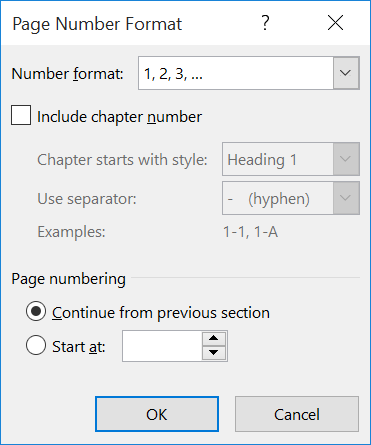
How to insert page numbers
Occasionally it may be necessary to insert a page number where one has disappeared.
- Go to the page and double-click in the header area at the top of the page.
- Click the "Page #" icon.

- Align the page number accordingly (right-justified for an odd page; left-justified for an even page)
Inserting Images
Make sure you have the image to be inserted stored on your computer. Do not do a copy and paste from another document or web page!- Place your cursor where the image should be inserted (make sure it's in a new paragraph)
- Put the paragraph in the "Figure,fig" style (see how to apply styles above)
- Go to the Insert menu > Picture.
- Select the file stored on your computer.
Tables and Lists
If you want to change the levels that appear in your table of contents, can either edit the field codes or delete and insert a new table. To edit the field codes:
- Left click to select the Table of Contents
- Right click the table, and choose “Toggle Field Codes”
- You should see something like [TOC \o “2-3” \t “Heading 1,1”]
- In this case, the table of contents will show Heading 1, Heading 2, and Heading 3, which will be chapter, subchapters, and subsubchapters.
- To modify the levels, simply change the numbers. If you want Headings 1 and 2, then change “2-3” to “2-2”
- If you only want Heading 1, you can remove \o “2-3”
To insert a new Table of Contents:
How to update tables and lists: